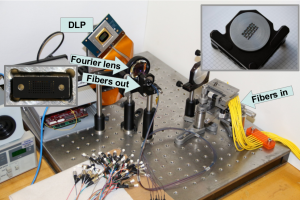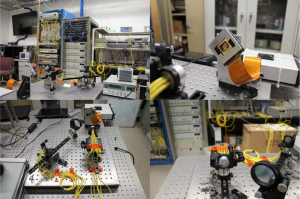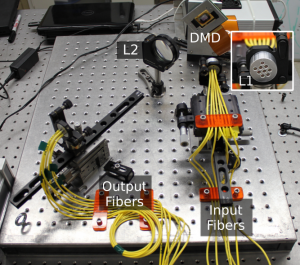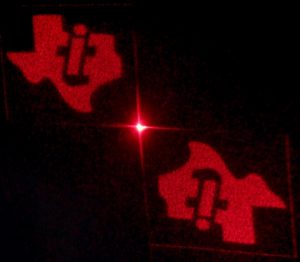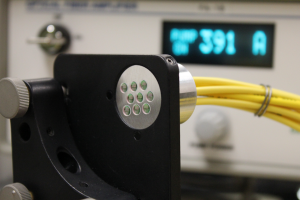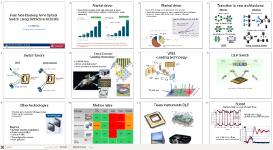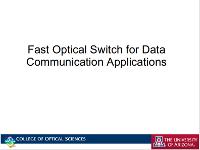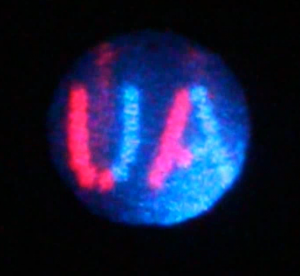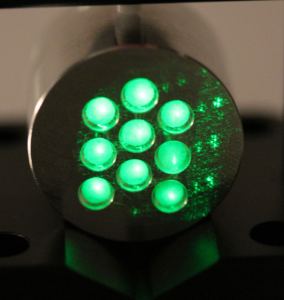Optical Switch
Abstract
Internet usage has exploded and is driving the need for increased telecommunication bandwidth. The annual international internet traffic and bandwidth growth has been over 40% the last 4 years, and is expect to continue on this trendline for the foreseeable future. The introduction of mobile devices such as smart-phones, and tablet PC have increased the number of IP connections exponentially. New and bandwidth demanding applications such as cloud computing, videoconferencing, social media, online gaming, or video-on-demand rely on this high bandwidth to provide content from the data centers to the end users.
In this project, we address a critical electronic element of the communication infrastructure: switching. It has long been recognized that optical switching has significant advantages over electronic switching. The performance of an optical switch is constant as a function of data rate and therefore future-proof to increases in bandwidth, in contrast to electrical switches that experience a performance “fall off” as a function of frequency. The principal barriers to deployment of OMEMS based optical switch have been cost (up to $1K per port and up), inadequate switching speeds (millisecond regime), insufficient numbers of ports (hundreds only), and reliability (failure of a mirror means failure of a port).
Our original idea is to implement an optical switch based on computer generated hologram displayed on digital micro-mirrors device (DMD). The reconfiguration time is 1,000 times larger than 3D MEMS, the number of ports could be hundred of thousands, the element can be use for multycasting, signal division and intensity normalization while the energy consumption is reduced and the the system has a compact footprint.
We gladly acknowledge the support from Texas Instrument, The NSF Center for Integrated Access Networks, Tech Launch Arizona , and the NSF I-Corps program for this project.
Publications:
- Youmin Wang et al., “2D broadband beamsteering with large-scale MEMS optical phased array“, Optica, 6, 557-562 (2019). Link
- P.-A. Blanche et al., “Diffraction-Based Optical Switching with MEMS“, MDPI Applied Sciences, 7(4), 411 (2017). Link
- P.-A. Blanche et al., “Special Section on the Interface of Holography and MEMS”, SPIE, JM3, J. Micro/Nanolith. MEMS MOEMS. 14 (4), (2015). Link
- P.-A. Blanche et al., “Fast Non-blocking NxN Optical Switch Using Diffractive MOEMS”, invited talk in Optical Fiber Communication Conference, Los Angeles, California, March, 2015 Link
- A. Miles et al., “7 x 7 DMD-Based Diffractive Fiber Switch at 1550nm”, Optics Communications, vol. 334, pp 41-45, (2015). Link
- P.-A. Blanche et al., “Digital micromirror device as a diffractive reconfigurable optical switch for telecommunication”, SPIE Journal of Micro/Nanolithography, MEMS, and MOEMS (JM3), 13 (1), 011104 (2013) Link
- B. Lynn et al. “Design and Preliminary Implementation of an N×N Diffractive All-optical Fiber Optic Switch”, IEEE/OSA Journal of Lightwave Technology, 31 (24), pp 4016 – 4021, December 2013 Link
- B.Lynn et al., “Fast Optical Switch for Data Communication Applications”. Poster presented during the annual workshop of The Optoelectronics Industry Development Association (OIDA) Anaheim, CA, March 2013 Link
- P.-A. Blanche et al., “DMD as a diffractive reconfigurable optical switch for telecommunication”, SPIE Photonics West, MOEMS/MEMS conference 8618, San Fransisco, February 2013 Link
Pictures and Videos
- Second prototype: 32×32 ports (click to enlarge)
- The optical switch first prototype during its integration into the CIAN TOAN testbed. (click to enlarge)
- The optical switch setup (click to enlarge)
- Ray tracing of the switch (click to enlarge)
- Texas Instrument logo diffracted from a DMD (click to enlarge)
- Bundle of 9 fibers and colimators as an input/output for the optical switch (click to enlarge)

